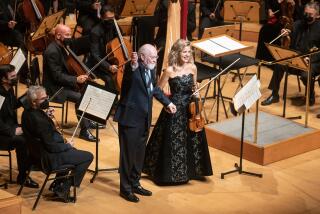Violinist Mutter Gives Brahms a Careful but Cool Treatment
- Share via
Noting the 100th anniversary of the death of Johannes Brahms, Anne-Sophie Mutter this season is playing the composer’s three sonatas for violin and piano in recitals throughout North America. This week, the German violinist, with her longtime accompanist, Lambert Orkis, brought this program, plus the early and brief “Sonatensatz” scherzo (1853), to the Dorothy Chandler Pavilion.
Having played these three works here in 1991, Mutter might be expected to repeat herself. That did not happen Wednesday night, when a large and festive crowd greeted her. Despite the 33-year-old player’s superior technique and musical aplomb, she failed to achieve the same level of concentration and authority remembered from the earlier performance.
All of the playing was secure, but some of it proved technically loose and musically bland. Mutter can be a cool interpreter, and, where Brahms is concerned, her approach has the ability to probe and clarify music that in other hands might become overheated.
This time, however, her coolness sometimes turned into indifference and her personal presence seemed missing. Her performances emerged perfunctory as well as less than immaculate.
Nevertheless, the sort of musical literalism in which Mutter specializes still operated in Brahms’ favor; if she achieved little in the way of sharp characterizations, she accomplished no disfigurement of the composer’s profile. What she painted most thoroughly were the relatively boisterous finales of all three sonatas, and the classically energetic “Sonatensatz.” She found gentleness, but seldom the deep caressing, in the contemplative, purely lyric movements.
Through it all, Orkis proved again a resourceful, willing and self-effacing collaborator. At the end, the pair took an encore and played Brahms’ Hungarian Dance No. 6.
More to Read
The biggest entertainment stories
Get our big stories about Hollywood, film, television, music, arts, culture and more right in your inbox as soon as they publish.
You may occasionally receive promotional content from the Los Angeles Times.










